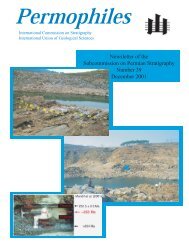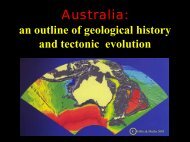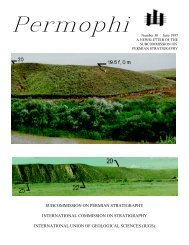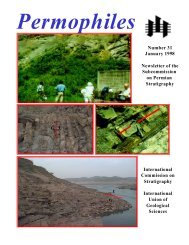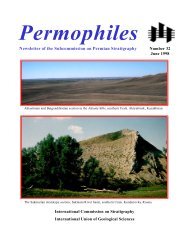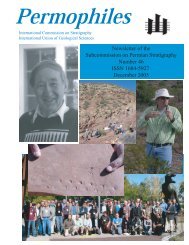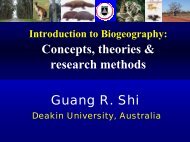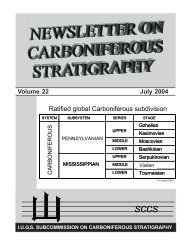Newsletter of the Subcommission on Permian Stratigraphy Number ...
Newsletter of the Subcommission on Permian Stratigraphy Number ...
Newsletter of the Subcommission on Permian Stratigraphy Number ...
You also want an ePaper? Increase the reach of your titles
YUMPU automatically turns print PDFs into web optimized ePapers that Google loves.
correctly pointed out that <str<strong>on</strong>g>the</str<strong>on</strong>g>re is a c<strong>on</strong>sensus that C. postbitteri<br />
is <str<strong>on</strong>g>the</str<strong>on</strong>g> ancestor <str<strong>on</strong>g>of</str<strong>on</strong>g> C. dukouensis and that this transiti<strong>on</strong> is<br />
gradualistic in character. In fact, it could be argued that <str<strong>on</strong>g>the</str<strong>on</strong>g> remainder<br />
<str<strong>on</strong>g>of</str<strong>on</strong>g> <str<strong>on</strong>g>the</str<strong>on</strong>g> Clarkina lineage proceeds al<strong>on</strong>g a very gradualistic<br />
course. It will be very difficult indeed for any<strong>on</strong>e to c<strong>on</strong>sistently<br />
pick a point within <str<strong>on</strong>g>the</str<strong>on</strong>g>se gradual chr<strong>on</strong>omorphoclines.<br />
Summary <str<strong>on</strong>g>of</str<strong>on</strong>g> Agreements and Disagreements<br />
Agreements<br />
1) Individuals involved with this boundary study agree that<br />
<str<strong>on</strong>g>the</str<strong>on</strong>g> morphologic differences between Jinog<strong>on</strong>dolella<br />
granti and Clarkina postbitteri are clear, regardless <str<strong>on</strong>g>of</str<strong>on</strong>g><br />
tax<strong>on</strong>omic approach.<br />
2) Individuals involved with this boundary study seem to<br />
agree that <str<strong>on</strong>g>the</str<strong>on</strong>g> first occurrence <str<strong>on</strong>g>of</str<strong>on</strong>g> C. postbitteri is in <str<strong>on</strong>g>the</str<strong>on</strong>g><br />
upper part <str<strong>on</strong>g>of</str<strong>on</strong>g> bed 6i (about 55 cm below <str<strong>on</strong>g>the</str<strong>on</strong>g> top <str<strong>on</strong>g>of</str<strong>on</strong>g> bed 18)<br />
and that all specimens in upper bed 6i and 6j are C.<br />
postbitteri.<br />
3) Individuals involved with this boundary study agree that<br />
C. postbitteri is <str<strong>on</strong>g>the</str<strong>on</strong>g> ancestor <str<strong>on</strong>g>of</str<strong>on</strong>g> C. dukouensis.<br />
4) Individuals involved with this boundary seem to agree<br />
that <str<strong>on</strong>g>the</str<strong>on</strong>g> general locati<strong>on</strong> for <str<strong>on</strong>g>the</str<strong>on</strong>g> Guadalupian-Lopingian<br />
boundary should be at <str<strong>on</strong>g>the</str<strong>on</strong>g> Penglaitan secti<strong>on</strong> in south<br />
China.<br />
Disagreements<br />
1) Individuals involved with this boundary do not agree as<br />
to <str<strong>on</strong>g>the</str<strong>on</strong>g> ancestry <str<strong>on</strong>g>of</str<strong>on</strong>g> C. postbitteri, in part because <str<strong>on</strong>g>of</str<strong>on</strong>g> different<br />
tax<strong>on</strong>omic approaches and expectati<strong>on</strong>s.<br />
2) Individuals involved with this boundary do not agree<br />
whe<str<strong>on</strong>g>the</str<strong>on</strong>g>r <str<strong>on</strong>g>the</str<strong>on</strong>g> first occurrence <str<strong>on</strong>g>of</str<strong>on</strong>g> C. postbitteri at Penglaitan<br />
is a true FAD or not.<br />
3) Individuals involved with this boundary do not agree <strong>on</strong><br />
exactly how to differentiate C. postbitteri from C.<br />
dukouensis.<br />
4) Individuals involved with this boundary do not agree as<br />
to <str<strong>on</strong>g>the</str<strong>on</strong>g> exact point for <str<strong>on</strong>g>the</str<strong>on</strong>g> base <str<strong>on</strong>g>of</str<strong>on</strong>g> Lopingian GSSP at<br />
Penglaitan, but have narrowed <str<strong>on</strong>g>the</str<strong>on</strong>g> choices to a limited<br />
interval.<br />
C<strong>on</strong>clusi<strong>on</strong><br />
Every<strong>on</strong>e involved in this debate is looking at specimens<br />
from <str<strong>on</strong>g>the</str<strong>on</strong>g> same samples; <str<strong>on</strong>g>the</str<strong>on</strong>g>se specimens are <str<strong>on</strong>g>the</str<strong>on</strong>g> facts. However,<br />
different viewpoints regarding tax<strong>on</strong>omic c<strong>on</strong>cepts result in different<br />
interpretati<strong>on</strong>s with respect to <str<strong>on</strong>g>the</str<strong>on</strong>g>se facts. I agree with Jin<br />
Yugan (see his report in this newsletter) that a good course <str<strong>on</strong>g>of</str<strong>on</strong>g><br />
acti<strong>on</strong> would be for several specialists to sit down toge<str<strong>on</strong>g>the</str<strong>on</strong>g>r and<br />
look at well-sampled material from Penglaitan; a point echoed by<br />
Wang in this issue. Wang also appears to agree that <str<strong>on</strong>g>the</str<strong>on</strong>g>re is<br />
c<strong>on</strong>sensus for <str<strong>on</strong>g>the</str<strong>on</strong>g> locati<strong>on</strong> <str<strong>on</strong>g>of</str<strong>on</strong>g> <str<strong>on</strong>g>the</str<strong>on</strong>g> Guadalupian-Lopingian boundary<br />
at Penglaitan, but not necessarily <str<strong>on</strong>g>of</str<strong>on</strong>g> <str<strong>on</strong>g>the</str<strong>on</strong>g> point. I also agree that<br />
we should be looking at this material from <str<strong>on</strong>g>the</str<strong>on</strong>g> viewpoint <str<strong>on</strong>g>of</str<strong>on</strong>g> populati<strong>on</strong>s.<br />
A possible venue for this collaborati<strong>on</strong> could be at <str<strong>on</strong>g>the</str<strong>on</strong>g><br />
NAPC meeting this summer (see notes from <str<strong>on</strong>g>the</str<strong>on</strong>g> SPS secretary, SPS<br />
Chairman and Jin Yugan’s report) or at Boise prior to NAPC. Perhaps<br />
we should be voting <strong>on</strong> some <str<strong>on</strong>g>of</str<strong>on</strong>g> <str<strong>on</strong>g>the</str<strong>on</strong>g>se alternatives (FAD <str<strong>on</strong>g>of</str<strong>on</strong>g><br />
C. postbitteri or C. dukouensis) prior to a general vote <strong>on</strong> <str<strong>on</strong>g>the</str<strong>on</strong>g><br />
boundary. This is a far better course <str<strong>on</strong>g>of</str<strong>on</strong>g> acti<strong>on</strong>, compared to trying<br />
to determine <str<strong>on</strong>g>the</str<strong>on</strong>g> boundary by who speaks loudest or last.<br />
Permophiles Issue #37 2000<br />
22<br />
On <str<strong>on</strong>g>the</str<strong>on</strong>g> Reliability <str<strong>on</strong>g>of</str<strong>on</strong>g> Ages and Distributi<strong>on</strong>s in <str<strong>on</strong>g>the</str<strong>on</strong>g><br />
revised Brachiopod Treatise<br />
Bruce Waterhouse<br />
25 Av<strong>on</strong> Street<br />
Oamaru, New Zealand Loris@xtra.co.nz<br />
Treatises <strong>on</strong> invertebrate fossils have provided a feeding<br />
ground for studies <str<strong>on</strong>g>of</str<strong>on</strong>g> life crises, distributi<strong>on</strong>s and o<str<strong>on</strong>g>the</str<strong>on</strong>g>r big picture<br />
<str<strong>on</strong>g>the</str<strong>on</strong>g>mes, and venturesome geologists use <str<strong>on</strong>g>the</str<strong>on</strong>g> treatises to match a<br />
fossil against illustrated genera, to determine not so much <str<strong>on</strong>g>the</str<strong>on</strong>g><br />
identificati<strong>on</strong> as <str<strong>on</strong>g>the</str<strong>on</strong>g> age and distributive relati<strong>on</strong>ships. So<br />
Permophiliacs should welcome <str<strong>on</strong>g>the</str<strong>on</strong>g> appearance <str<strong>on</strong>g>of</str<strong>on</strong>g> two volumes <str<strong>on</strong>g>of</str<strong>on</strong>g><br />
<str<strong>on</strong>g>the</str<strong>on</strong>g> revised Brachiopod Treatise (Vol. 2, 3. Linguliformea,<br />
Craniiformea, and Rhynch<strong>on</strong>elliformea (part). Ed. R. L. Kesler. The<br />
Geological Society <str<strong>on</strong>g>of</str<strong>on</strong>g> America and The University <str<strong>on</strong>g>of</str<strong>on</strong>g> Kansas, Boulder,<br />
Colorado, and Lawrence, Kansas, 2000). But an initial glance<br />
through <strong>Permian</strong> genera within <str<strong>on</strong>g>the</str<strong>on</strong>g> Productidina, <str<strong>on</strong>g>the</str<strong>on</strong>g> most prominent<br />
<str<strong>on</strong>g>of</str<strong>on</strong>g> <strong>Permian</strong> brachiopod suborders, suggests that any data<br />
base from <str<strong>on</strong>g>the</str<strong>on</strong>g>se treatise volumes will be very unreliable. Here is a<br />
précis <str<strong>on</strong>g>of</str<strong>on</strong>g> genera c<strong>on</strong>sulted – <str<strong>on</strong>g>the</str<strong>on</strong>g>y may be discovered through<br />
c<strong>on</strong>sulting <str<strong>on</strong>g>the</str<strong>on</strong>g> index in volume 3. I put my comments in brackets<br />
after quoting <str<strong>on</strong>g>the</str<strong>on</strong>g> Treatise. I set aside where possible <str<strong>on</strong>g>the</str<strong>on</strong>g> treatise’s<br />
old-fashi<strong>on</strong>ed two-fold <strong>Permian</strong>, with Roadian in <str<strong>on</strong>g>the</str<strong>on</strong>g> Lower <strong>Permian</strong>,<br />
and I abbreviate <str<strong>on</strong>g>the</str<strong>on</strong>g> standard and Russian stage names –<br />
<str<strong>on</strong>g>the</str<strong>on</strong>g>y are fully spelled out in this, but not all treatises. To save<br />
space, LP, MP, UP stands for Lower, Middle and Upper <strong>Permian</strong>.<br />
For a few genera I comment <strong>on</strong> distributi<strong>on</strong>, with + to indicate<br />
additi<strong>on</strong>al countries, which should have been incorporated, but<br />
were not.<br />
Thailand<br />
The following genera all come from near <str<strong>on</strong>g>the</str<strong>on</strong>g> base <str<strong>on</strong>g>of</str<strong>on</strong>g> what is<br />
called <str<strong>on</strong>g>the</str<strong>on</strong>g> Rat Buri Limest<strong>on</strong>e in south Thailand. Originally assigned<br />
to <str<strong>on</strong>g>the</str<strong>on</strong>g> Kazanian (Wordian) Middle <strong>Permian</strong> by Waterhouse<br />
& Piyasin (1970), <str<strong>on</strong>g>the</str<strong>on</strong>g>y were reallocated to Artinskian by Grant<br />
(1976) through correlati<strong>on</strong> with <str<strong>on</strong>g>the</str<strong>on</strong>g> Bitauni fauna <str<strong>on</strong>g>of</str<strong>on</strong>g> Timor and<br />
Amb Formati<strong>on</strong> <str<strong>on</strong>g>of</str<strong>on</strong>g> <str<strong>on</strong>g>the</str<strong>on</strong>g> Salt Range, Pakistan. Waterhouse (1981)<br />
revised Grant’s correlati<strong>on</strong>s to defend a post-Artinskian age, and<br />
later c<strong>on</strong>od<strong>on</strong>ts showed <str<strong>on</strong>g>the</str<strong>on</strong>g> Bitauni and Amb were much younger<br />
than thought by Grant (Dr Heinz Kozur, pers. comm.) The lower<br />
Rat Buri is now generally regarded as Wordian (Angiolini et al.<br />
1998, Archbold 1999a). But <str<strong>on</strong>g>the</str<strong>on</strong>g> Treatise <str<strong>on</strong>g>of</str<strong>on</strong>g>fers a mixture <str<strong>on</strong>g>of</str<strong>on</strong>g> ages –<br />
for genera from <str<strong>on</strong>g>the</str<strong>on</strong>g> same fauna.<br />
Septasteges (“syn.”), Celebetes, Comuquia Artinskian.<br />
Dyschrestia upper Artinsk.<br />
Otariella Artinsk. – lower Kung.<br />
Globosobucina Road.- Word.<br />
Any reader would think <str<strong>on</strong>g>the</str<strong>on</strong>g>re were several different faunal levels.<br />
There is <strong>on</strong>e, as far as we can tell. And c<strong>on</strong>gratulati<strong>on</strong>s to<br />
Rachebouef and Williams & Brunt<strong>on</strong>, who menti<strong>on</strong>ed<br />
Strioch<strong>on</strong>etes and Miniplanus and o<str<strong>on</strong>g>the</str<strong>on</strong>g>r suborders from <str<strong>on</strong>g>the</str<strong>on</strong>g> same<br />
level, got <str<strong>on</strong>g>the</str<strong>on</strong>g> age right. So we have given for <strong>on</strong>e locality al<strong>on</strong>e,<br />
three different ages. The treatise secti<strong>on</strong> <strong>on</strong> Productidina for Thai<br />
<strong>Permian</strong> ages is so c<strong>on</strong>fused, that it is unusable.



